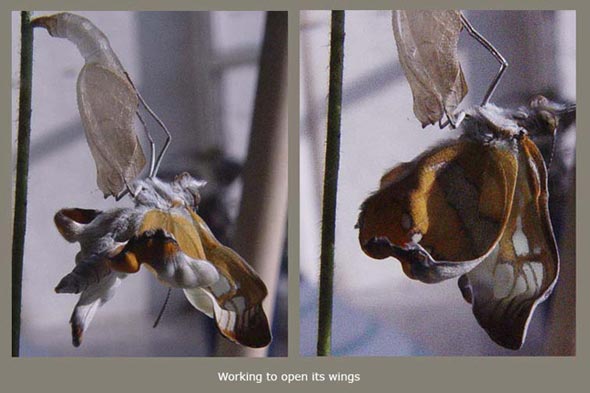news | new works | shows | making of a life cycle painting | newsletter
The
Making of a Butterfly Life Cycle
 To
me, painting just an adult butterfly is like presenting
only the last act of a play. Researching a butterfly's
complete lifecycle is about piecing together a puzzle.
I chase after elusive pieces -- observing in the wild,
connecting with a network of naturalists, combing through
libraries. Every butterfly has a host plant to which
it is connected and must have access in order to develop To
me, painting just an adult butterfly is like presenting
only the last act of a play. Researching a butterfly's
complete lifecycle is about piecing together a puzzle.
I chase after elusive pieces -- observing in the wild,
connecting with a network of naturalists, combing through
libraries. Every butterfly has a host plant to which
it is connected and must have access in order to develop
These plants too
have lifecycles, and observing them is often the starting
point of what I do. Only when I have each of six elements
in place -- habitat, host plant, egg, caterpillar, chrysalllis
and adult, can I finally begin painting. We’re
talking months, even years in elapsed time.
I
start out by painting a loose abstract background--setting
the composition and palette of colors I will use in
the rest of the work. I then overlay, element by element,
the host plant and lifecycle of the butterfly.
I
carefully pick perspectives to bring out distinctions
between butterflies in flight, and at rest; males versus
females; and so on. I regularly include small hidden
elements that make each lifecycle distinctly interesting.
Some people have asked why there is not a subject at
the center of my works. This is by design--I am painting
a cycle and creating a path which the eye follows around
the painting, seeing the growth and change, the metamorphosis,along
the way.
 Some
butterflies I’ve raised from egg to adult--detailing
their development through close-up digital photography.
An example is the Common Mestra, a small tropical brushfoot
butterfly with about a two inch wingspan. It’s
found in South Texas and Mexico. Known also as the “Noseburn
Wanderer” because it strays northward, its caterpillar
feeds on the noseburn plant. The tiny white hairs on
the stems and leaves of this plant are irritating so
the caterpillar is somewhat protected from predators,
but not from gardeners who pull it out because it is
irritating to the skin -- and can get overgrown and
unsightly. A discriminating eye however might see its
small but beautiful white blossom - and peering through
a handlens, a tiny caterpillar or miniscule egg on a
leaf. Some
butterflies I’ve raised from egg to adult--detailing
their development through close-up digital photography.
An example is the Common Mestra, a small tropical brushfoot
butterfly with about a two inch wingspan. It’s
found in South Texas and Mexico. Known also as the “Noseburn
Wanderer” because it strays northward, its caterpillar
feeds on the noseburn plant. The tiny white hairs on
the stems and leaves of this plant are irritating so
the caterpillar is somewhat protected from predators,
but not from gardeners who pull it out because it is
irritating to the skin -- and can get overgrown and
unsightly. A discriminating eye however might see its
small but beautiful white blossom - and peering through
a handlens, a tiny caterpillar or miniscule egg on a
leaf.

With the help of digital photography,we can see the
entire miracle from the egg to the emerging butterfly,
literally unfolding and coming to life as a winged adult.









The last image
is of my life cycle. My aim is to attract people to
natural subjects through my art, and to share interesting
information about both the creatures and the host plants
that sustain them.

Common Mesta (Mestra amymone) |